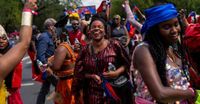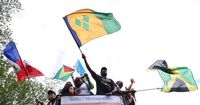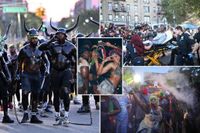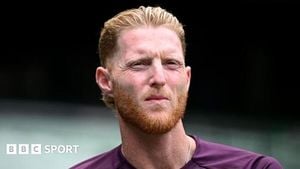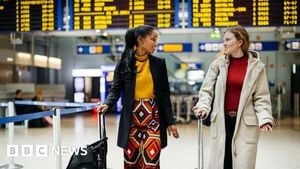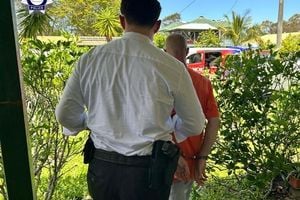The West Indian American Day Parade, one of Brooklyn’s most vibrant and anticipated annual celebrations, ended in tragedy on September 1, 2025, as gun violence marred the festivities despite a significant police presence and heightened security measures. What began as a jubilant display of Caribbean culture and unity descended into chaos as six individuals were shot and another was slashed along the parade route, leaving the community rattled and city officials under renewed scrutiny.
The day commenced with the traditional J’Ouvert celebration, a pre-dawn explosion of music, dancing, and revelers smeared in colorful paint, oil, and powder. By 11 a.m., the official parade had kicked off on Utica Avenue near Lincoln Terrace Park, winding its way westward toward the Brooklyn Museum. Hundreds of thousands of participants, many wrapped in flags representing a tapestry of Caribbean nations, filled the streets. The event drew not only locals but also a bevy of political figures, including Mayor Eric Adams, Governor Kathy Hochul, former Governor Andrew Cuomo, New York Attorney General Letitia James, and mayoral candidates Zohran Mamdani and Curtis Sliwa, all eager to connect with voters and celebrate the city’s rich cultural diversity.
Security was a visible priority. According to New York Post, the NYPD deployed a record number of officers, established 13 security checkpoints equipped with handheld metal detectors, and erected two rows of barricades along the parade route—an increase from previous years. Spectators underwent thorough screening before entering, and the police presence was felt everywhere. "I like it like this. The cops are around. They are with the people," said Harold Harvey, a 71-year-old Grenada native who has lived in Crown Heights since 1979. Another longtime attendee, Oslyn, remarked, "It’s good that more police are here. And you see the helicopter overhead, too. It’s deterring those bad elements, definitely. Everywhere you turn, you see [cops] and that’s good. I commend the mayor and police commissioner."
Despite these precautions, violence erupted as the day wound down. The first shooting was reported around 5:35 p.m. on Eastern Parkway, near the heart of the parade route. According to PIX11 and NYPD sources, a man in his 20s was shot in the leg and a woman in her 40s was grazed by a bullet. Both were transported to Kings County Hospital Center and were listed in stable condition. Just minutes later, at around 6:15 p.m., another shooting occurred about 2.5 miles away on Nostrand Avenue near Sterling Place. This time, a 40-year-old woman and a 53-year-old man were struck by gunfire. Police were able to apprehend a suspected shooter at this location.
The violence did not end there. At approximately 6:30 p.m., two more individuals—a 26-year-old woman and a 21-year-old man—were shot on Eastern Parkway. The man suffered a gunshot wound to the chest, while the woman was hit in the shoulder. Five shell casings were recovered at the scene, but the assailant remained at large as of Monday evening. In a separate incident, a man was slashed near Nostrand Avenue and Eastern Parkway, though he refused medical attention, according to police reports.
Further details provided by PIX11 indicated that, in addition to the shootings at the parade route, an incident occurred on Ocean Parkway between Schenectady and Utica Avenues. A woman was grazed in the buttocks, and a man was shot in the leg. Both were taken to Kings County Hospital. Another shooting at Eastern Parkway and Classon Avenue left a man with a shoulder wound; a second man with a similar injury walked into the same hospital for treatment. Outside the Yard Pot Restaurant and Bakery on Nostrand Avenue and Sterling Street, a man was shot in the leg and neck and was listed in critical condition. The NYPD continues to investigate these incidents, urging anyone with information to contact Crime Stoppers.
For many parade-goers, the violence was a chilling reminder of the event’s troubled history. The West Indian American Day Parade has long been celebrated for its exuberance and sense of community, but it has also been shadowed by periodic outbreaks of violence. The most notorious incident occurred in 2015, when Carey Gabay, an aide to then-Governor Cuomo, was fatally shot in the head by a stray bullet during J’Ouvert. Marking the 10th anniversary of Gabay’s death, Cuomo reflected, "Carey was caught in the crossfire of a gang shootout, a senseless act of violence while he was simply walking home. His life was taken at a time when he was doing everything right: Giving back to his community, serving his state, and working toward a more just New York."
Despite the tragic turn of events this year, many attendees remained resolute in their commitment to the parade and its traditions. Maureen Bellinger, a 77-year-old retired social worker from Trinidad, shared, "We still enjoy our culture even though we’ve been living here for a long time. When I was young, I used to come with my mother. When my children were younger, I took them to continue the tradition … I’m having a good time. I told my daughter I’d go home after I see her, but I ain’t going home yet!" Harold Harvey echoed this sentiment: "This makes me feel good and closer to home today. People waving flags from different countries, but we are all one. It’s a Caribbean thing!"
For city officials, the day’s violence was a stark challenge to their efforts to ensure public safety at large-scale events. The NYPD’s increased deployment and stringent security measures were widely praised by many in attendance, but the persistence of gun violence highlights the complexity of addressing crime in a city as diverse and dynamic as New York. As investigations continue and the community grapples with the aftermath, the parade’s dual legacy—as both a joyous celebration and a site of tragedy—remains unresolved.
Even in the face of adversity, the West Indian American Day Parade endures as a testament to the resilience and unity of Brooklyn’s Caribbean community. The hope among many is that future celebrations will be remembered for their joy and cultural pride, not for the violence that has too often overshadowed them.
